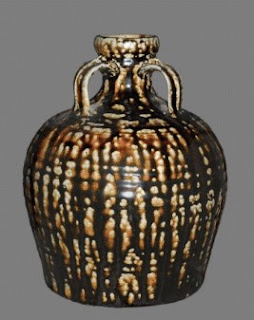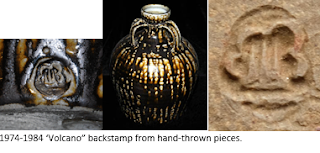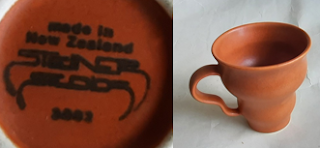Artist and craftsman
Click here for Bob Steiner's website
Image Bob Steiner
In 1984 Bob Steiner moved back to Auckland after his marriage ended. He soon met up with ceramic artists Christine Harris and Rose Wallis, both based at the D’Art Studios co-operative, and their work inspired him to move from earthy hand-thrown ware to slipcasting and decorating in bright clear colours.
In the Hokianga, Steiner had been experimenting with his hand-thrown pieces, slicing them with a knife or thin wire and reshaping them by hand to create angular forms that could not be achieved using a wheel alone. In Auckland he learned how to replicate the new shapes over and over by slipcasting in moulds. The new techniques created the popular 'Swirl' teaset, with its unusual curves and cut-out lids. Other ware created in this way included the Swirl dinner set – its plates and bowls had cut-out sides.
Image Bob Steiner
Often glazed with different shades inside and out, Bob Steiner’s new ware was snapped up by Aucklanders looking for new lively shapes and fresh bright colours. A Swirl tea-set gained a merit award in the 1986 Fletcher Brownbuilt ceramic awards.
Initially working mostly on his own, Steiner developed his shapes and techniques and used plain glazes rather than brushwork. Rose Wallis decorated some early work with floral patterns. New shapes included deco-style ware - mugs, teapots, milk jugs and sugar bowls.
At first production was on a small scale. He sold from the D’Art Studio premises, and sometimes from stalls at the Victoria Park and Oriental Markets. Soon shops throughout New Zealand were keen to stock his work. One prominent retailer was the New Vision Gallery in Auckland.
The business stepped up in 1988 when Steiner established a workshop in his basement at home and began working with ceramic artist Sharyn Maude. Together they developed a range decorated with brightly coloured brushwork. Most of their collaborative work bears the Eido stamp. The pair joined the Pots of Ponsonby co-operative and had a very successful four years before going their separate ways. For a time after the partnership ended, Sharyn Maude made very similar mugs, marked with her name only.
Image Bob Steiner
Valerie Monk
Occasionally collectors come across Crown Lynn shapes with the Steiner/Sharyn Maude Eido backstamp. After Crown Lynn closed in 1989, Steiner bought a whole lot of unglazed blanks – mainly dinner plates and a few odds and ends like gravy boats from the 1980s Modello Collection. The blanks were decorated at the Steiner workshops and on-sold.
Valerie Monk
Many of the shapes Bob Steiner developed during the late 1980s-1990s are still in production – for example tall Cuba jugs, vases, assorted mugs and coffee pots, and teapots and cups and saucers. A classic rounded teapot set was inspired by the German Bauhaus design movement.
Image Bob Steiner
A line of vases still being made today dates back to Bob’s original technique, slicing and reshaping hand-thrown ware. The Cactus, Round Leaf and Pointed Leaf vases were first made in 1986. They were difficult to slipcast until the moulds were remade by retired Crown Lynn modeller John Cowdery.
Image Bob Steiner
After a decade working in co-operatives, in 1991 Bob Steiner opened his own workshop and retail business at 440 Kingsland Road. For a couple of years he also sold at Pots of Ponsonby but that relationship faded as turnover grew at the main shop. After the move to Kingsland, Bob ventured into more sculptural work, including striking eccentric pieces like his rockets and lionfish.
Valerie Monk
By now Bob had joined forces with Frana Stanish and together they developed a range of colourful patterns applied with brushes and hand-cut sponges. At its height the business employed five women decorators. The best-selling design was Aster which came in three colourways – marigold, purple and green. The Cactus and Anemone patterns were also popular. These sponged and hand-brushed styles peaked around the mid-1990s. In 1996 Frana Stanish left the business, but her patterns were replicated for a couple more years by another decorator, Jo McClean.
Valerie Monk
Toward the end of the 1990s the market for multi-coloured hand painted ware was fading and Steiner created his bold single-colour matt glazes, including the very popular electric blue.
Image Bob Steiner
In 2002 Reg Matthews, originally from Beach Artware, began working with Bob Steiner. He suggested a range of square wall hangings. Inspired by his association with the native bush in the Hokianga, Bob developed a very successful new line of wall art, at first rectangular and square plaques, and later birds, leaves and flowers. All of these pieces can be arranged on a wall in an endless variety of configurations.
Image Bob Steiner
In 2009 Steiner Studios moved from the home workshop to a purpose-built pottery in Avondale. In 2002 Bob remarried and his wife Alison Steiner was very active in the business, particularly in management, business development and strategy. Bob and Alison had a son together.
Today, a small team continues to recreate Bob Steiner classics – and he still keeps the work exciting by creating new pieces. New shapes are first roughed out in clay, then finely sculpted in plaster. Slipcasting moulds are made from the final plaster prototype.
Image Bob Steiner
Steiner takes much of his inspiration from New Zealand culture, often incorporating tapa and koru designs. Looking to nature for inspiration, there are skillfully rendered flowers, leaves, birds, bees, and a sea creatures series including shells, starfish and fish. Some small dip bowls were created using the direct imprint of a leaf – eg totara, taraire and fern. Birds include the New Zealand ruru, tui and the ever-popular fantail (piwakawaka).
Image Bob Steiner
 Above: Steiner once bought a fresh hapuku - a substantial purchase at $100. A wall decoration was modelled from the complete fish, and then it was turned into a sumptuous meal. Later, the picked-over skeleton served an artistic purpose. The bones were cleaned then used to model a series of decorative wall plaques.
Above: Steiner once bought a fresh hapuku - a substantial purchase at $100. A wall decoration was modelled from the complete fish, and then it was turned into a sumptuous meal. Later, the picked-over skeleton served an artistic purpose. The bones were cleaned then used to model a series of decorative wall plaques. Image Bob Steiner

Private collection
Bob Steiner has also made one-off sculptures, some simply for his own satisfaction and others for fundraising for organisations, eg Tiritiri Matangi Island.
Image Bob Steiner
Image Bob Steiner
Image Bob Steiner
Other more pragmatic work includes the development of stylish and durable restaurant ware. For the hospitality industry, ware must resist chipping and staining, and be able to withstand endless dishwashing cycles. That work has paid off, now Steiner ware is used by many of Auckland’s top eateries.
Image Bob Steiner
Bob Steiner timeline
1974 began professional pottery in Kohukohu in the Hokianga . Hand-thrown ware carries the impressed volcano mark symbolising earth and fire.
1984 – moved back to Auckland and began making cut-sided ware, including plates, bowls, tea sets. Deco cups were also quite early and later deco teapots with the zig-zag pointed handles. Ware from this period is marked with the Bob Steiner New Zealand signature stamp (see backstamps below).
C1985-1991 Eido branded with Sharyn Maude
1986 Fletcher Brownbuilt Awards certificate of merit
1986 D’Art Studio folded and Steiner travelled to the US.
1988 After return from overseas, set up a workshop in his basement
1991 – opened Steiner Studios shop in Kingsland
From 1992 - C1997 Frana Stanish two backstamps. Frana and then the smaller FS
C1993/4 single colour matt glazes developed
1997 Steiner began putting dates on his backstamps from this year
2002-2003 Reg Matthews joined, began making wall art
2005 wall art first appears in trade show displays
2005 transparent stick-on labels used
C2003 began making dip bowls imprinted with natural leaves
2008 piwakawaka and large tui appear in trade show displays
2008 wall art squares appear in trade show displays
2008 University of Auckland 125 years commemorative gift
2009 wall art flowers appear in trade show displays
2009 moved from a home workshop to new premises in Avondale
2010 first lamp bases in trade show displays
2012 large snapper in trade show displays
Bob Steiner marks and backstamps.
1974-1984"Volcano" mark on hand-thrown pieces.
- Bob Steiner's website www.steinerceramics.co.nz
- Interviews with Bob Steiner by Valerie Monk and Ev Williams (2016)
- Following that interview, Bob provided me with a selection of photographs and catalogues, and also added more information via informal conversations, documents and emails.
- The New Zealand Pottery website www.newzealandpottery.net
- Thanks also to Alison Steiner who complied records for my use and for future researchers.










































Great blog, lots of info and photos are helpful. I have just bought a pair of Frana decorated mugs from 1992 and I only know this because of your article. Thanks, Val!
ReplyDeleteLovely - always glad to inspire collectors of our NZ heritage.
Delete